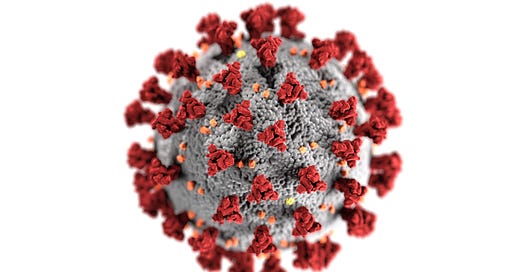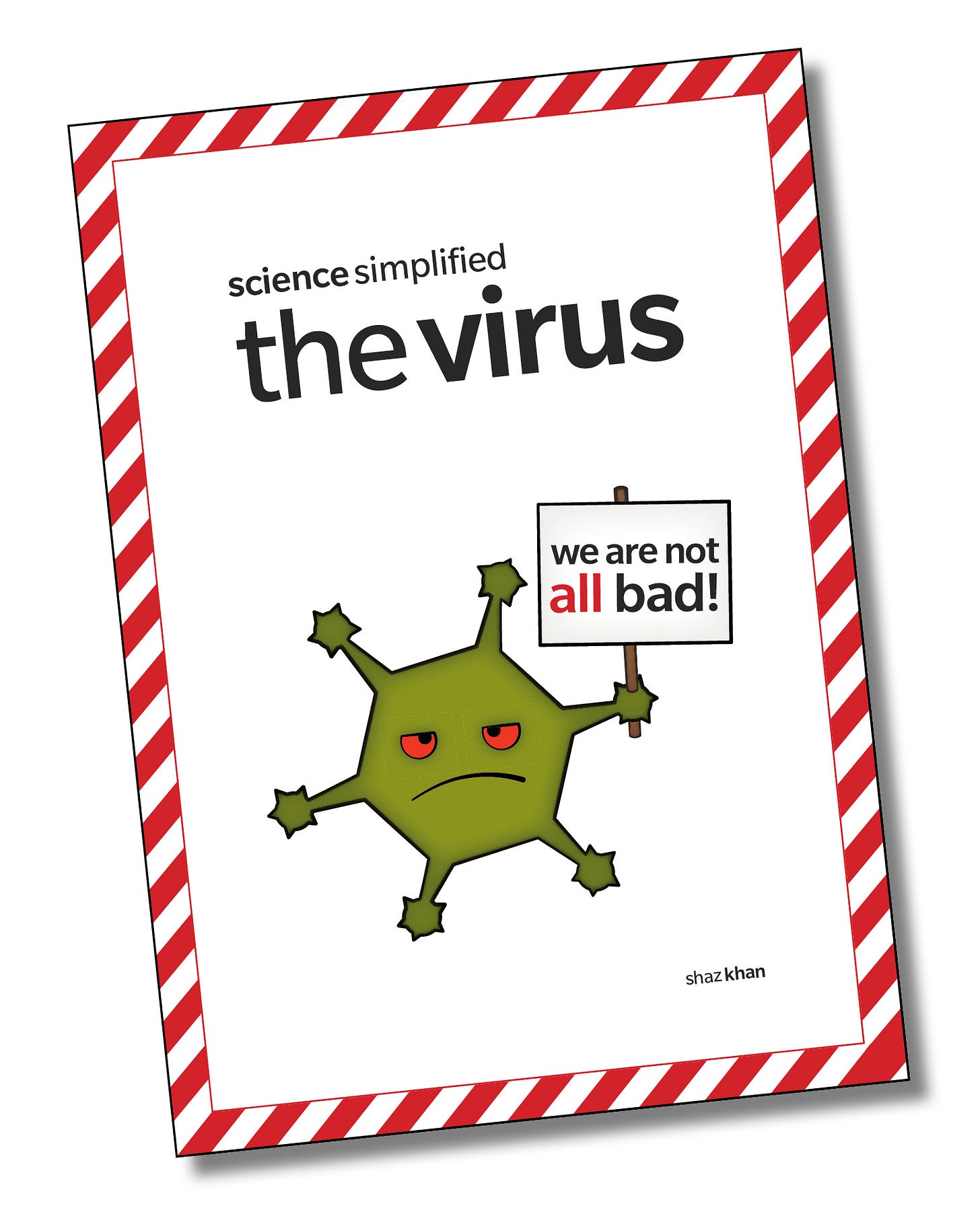Viruses: Friends or Foes?
It is important now more than ever to scrutinize what science currently understands and fails to fathom about the complex nature and diversity of viruses.
"So powerful and ancient are viruses, that I would summarize their role in life as ‘Ex Virus Omnia’ (from virus everything)."
—Professor Luis P. Villarreal
American Professor Emeritus, Molecular Biology and Biochemistry, School of Biological Sciences, University of California, Irvine and Founding Director of the Center for Virus Research at UC Irvine.
We know now how important and vital bacteria are for health, but what do we really know about viruses and their importance in the body?
Are viruses protein packets of genomic information necessary for adaption and survival, or are they nasty parasitic pathogens designed to make us sick? Can both these statements be true?
Researching immunization means inevitably coming across viruses, the first famous ones being poxviruses from the Poxviridae orthopoxvirus family. The Great Pox was the early name given to syphilis, but was distinct and different from the most famous vintage virus: smallpox—also called variola major1 and minor (alastrim).
The Poxviridae family was formally recognized in viral taxonomy in 1971 by the International Committee on Taxonomy of Viruses (ICTV), which established the modern system for classifying viruses based on morphology, nucleic acid type, replication, host, and disease characteristics.
In 1958, the World Health Assembly (WHA) called for the “global eradication of smallpox – the permanent reduction to zero cases – without risk of reintroduction.” From 1966, the international effort was led by Johns Hopkins’ Public Health graduate, US physician, CDC2 epidemiologist and EIS3 agent Donald A. Henderson, and was claimed to be stunningly successful. By December 1979, this was claimed to be achieved primarily through vaccination—smallpox was conquered and declared eradicated at the 33rd WHO WHA in May 1980.
Pandemics in the last 200 years have only ever been viral: influenza (H1N1) and SARS (Cov-1/Cov-2). All Public Health Emergencies of International Concern (PHEIC) have also only ever been for viruses: H1N1, polio, Ebola, Zika (virus transmitted by mosquito), MERS, SARS-Cov-2, monkeypox (Mpox).
While AIDS is not currently considered a pandemic or a PHEIC, the virus that is claimed to cause the collection of over 30 symptoms, human immunodeficiency virus (HIV), remains the second most famous virus after SARS-CoV-2. Despite over US$40 billion and 40 years of research, science has yet to yield a single viable HIV vaccine.
Viruses under the microscope

Viruses are studied outside their natural environment, taken from tissue or fluids, grown on animal or human cells, and stained with chemicals. They can be viewed using TEM, showing shadows of planes that are constructed to make three-dimensional, black and white images—red and green color images became available in 2016.
Other viewing instruments include cryo-electron microscopy and atomic force microscopy. Despite neither method requiring staining nor radiation beaming, they both have limitations. These expensive and sophisticated technologies display partial information—a snapshot taken in isolation of the viral ecosystem—only providing a computerized composite of approximate structure.
Viral taxonomy—the evolving art of virus categorisation—is complicated due to the huge number of viruses on this Earth. Cataloguing viruses is based on morphology (icosahedral, helical, complex—naked or enveloped), nucleic acid type (single or double stranded DNA or RNA), replication, host, and disease characteristics. This Baltimore Classification, named after US scientist David Baltimore who created the system, was established in 1971.
As of March 2020, scientists have identified 55 orders, 168 families, 1,421 genera, and 6,590 species of virus. Less than 200 are considered “pathogenic.”
Nobody really knows how many viruses there are, though molecular biologists and virologists estimate that there may be around 10 to the power of 31 viruses in the biosphere. That is 1 followed by 31 zeros: 10,000,000,000,000,000,000,000,000,000,000
"Life on Earth has evolved in a never-ending, profoundly symbiotic interaction with co-evolving viruses. We humans, like all cellular life, inhabit and are inhabited by, Earth's virosphere."
—Dr. Frank Ryan, "Virusphere: Ebola, AIDS, Influenza and the Hidden World of the Virus"
English fiction-writer, pioneering evolutionary biologist and honorary Senior Lecturer, Department of Medical Education at the University of Sheffield, UK.
Are viruses dead or alive? Or both?
The definition of an entity that is living is generally based on six key principles:
A self-sustaining, organized system made up of one or more cells
Capable of processing energy through metabolism
Able to maintain homeostasis
Responsive to environmental stimuli
Capable of reproduction and passing genetic information to offspring
Able to grow, develop, and adapt over time
Viruses do not clearly come under these principles, therefore they are not typically defined by scientists as being “alive.” When referred to in the context of vaccines, viruses are defined as “live-attenuated” or “killed” because the viral antigen (measles virus for example) has been attenuated or completely inactivated (polio).
Seeing as viruses only exist in living beings, they should automatically be considered “alive.” Outside cells, viruses are believed to be dormant and inactive, in “hibernation” so to speak, only triggered into activity when some electrobiochemical signal is received, sparking them into action. Once inside a cell, viral genetic material borrows the cell machinery to reproduce itself and continues the cycle for as long as there is “infection.”
Viruses are fascinating, especially in the current climate of pandemics.
In 2017, I decided to get my hands on whatever information I could find to investigate what science currently understands about these tiny entities called viruses.
Geeking down the avenue of virology, I began with following an online virology course with Vincent R. Racaniello at the Columbia University, who also wrote Principles of Virology. I borrowed his hefty two-volume book and others from the library, then purchased several more on Amazon.
My virology bibliography:
The Virus: A History of the Concept
Sally Smith Hughes
Heinemann Educational Books, 1977
Virus Mania
Torsten Engelbrecht, Claus Köhnlein
Trafford Publishing, 2007
Fear of the Invisible
Janine Roberts
Impact Investigative Media Productions, 2nd edition 2009
Virology: Molecular Biology and Pathogenesis
Leonard C. Norkin
ASM Press; 1st edition, 2009
Virus Taxonomy, the Ninth Report of the International
Committee on Taxonomy of Viruses
Andrew King, E. Lefkowitz, Michael J. Adams, Eric B. Carstens
Elsevier Inc.; 1st edition 2011
Human Virology
Leslie Collier, John Oxford, Paul Kellam
Oxford University Press; 4th edition, 2011
Viruses: Essential Agents of Life
Editor: Günther Witzany
Springer, 2012
Viruses and Man: A History of Interactions
Milton Taylor
Springer, 2014
Essential Human Virology
Jennifer Louten
Academic Press / Elsevier Inc., 2016
Viruses: More Friends Than Foes
Karin Moelling
World Scientific Publishing Co., 2016
Virusphere
Dr. Frank Ryan
William Collins, 2019
I reviewed the controversial views of Dr. Stefan Lanka, Dr. Claus Köhnlein, Dr. Sam Bailey, Dr. Mark Bailey, Dr. Thomas Cowan, Dr. Andrew Kaufman and Christine Massey, who claim that viruses do not exist and that the scientific field of virology is a farce. They argue that what is classed a virus, may actually be an exosome. This may well be true, but will we ever have a way of knowing for sure?
One thing is certain, 99.999% of humans will never ever see a virus. We depend on scientists with expensive microscopes and government authorities to affirm their existence as distinct pathogenic entities. Even the lab technicians working with virus-infected cells in petri dishes will never actually observe a virus with their naked eyes, as they are nanoscaled.
The illustration below has three visual examples of the size and the scale of nanotechnology, showing just how small things at the nanoscale actually are.
In order to bring some simplicity and understanding to the complex nature of viruses, I embarked on writing an illustrated 100-page book about the science on viruses, available now in English or French.
It took four years from concept to publication, with a one year break in 2019. When an unknown coronavirus reared its ugly head in early 2020, I knew I had to kick my butt into high gear and finish this book.
If you’re interested in learning more, you can purchase and download the digital English version here, or buy a physical copy in English or French on Amazon.
Science is an ever-evolving process of refining and expanding knowledge.
Some online references
House of Numbers – Anatomy of an Epidemic
2009 documentary by Brent Leung
www.houseofnumbers.com
Institute of Columbia – understanding viruses
Virology lecture series with virologist Vincent Racaniello
www.virology.ws
This Week in virology
www.microbe.tv/twiv/s
International Committee on Taxonomy of Viruses
talk.ictvonline.org
Dr. Stefan Lanka
wissenschafftplus.de/uploads/article/Dismantling-the-Virus-Theory.pdf
Dr Zach Bush – the Virome Webinar
www.youtube.com/watch?v=pJxjdGtuEs4
Variola major was the more severe form of the disease with a 20–30% mortality rate. It was largely replaced in developed countries in the late 1800s by Variola minor, also called alastrim, with a mortality rate from 1–10%. It could still be a disfiguring disease leaving ugly scars, but provided life-long immunity from future infection.
Centers for Disease Control – Initially called the Communicable Disease Center upon its founding on July 1, 1946
https://www.cdc.gov/mmwr/preview/mmwrhtml/00042732.htm
Epidemiologic Intelligence Service (est. 1951)
https://www.cdc.gov/eis/php/about/index.html










